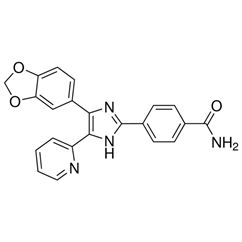PODS® Human MANF
PODS® Technology
PODS® proteins are made using an insect cell expression system in which the active protein is co-expressed alongside polyhedrin carrier protein. Polyhedrin forms microcrystals within insect cells which specifically capture the active protein to form a co-crystal complex. The active protein is captured in its nascent, natively folded form with limited scope for proteolytic degradation. Consequently, excellent levels of bioactivity are observed. The PODS® co-crystals provide a sustained release mechanism and can be used to functionalize surfaces. For further details, please refer to the PODS® Technology page.
Product Description
The product contains the polyhedrin protein co-crystalized with Human MANF. Mesencephalic Astrocyte-derived Neurotrophic Factor (MANF), also known as ARP and ARMET, is secreted and localized at the endoplasmic reticulum (ER) and Golgi apparatus, and expressed in brain, neuronal and certain non-neuronal tissues. MANF selectively protects nigral dopaminergic neurons, versus GABAergic or serotonergic neurons, which suggests that this protein may be indicated for the treatment of neural diseases, such as Parkinson's disease.
Usage Recommendation
PODS® are pure protein co-crystals consisting of polyhedrin, a structural scaffold protein, and a cargo protein. Under the action of proteases, which degrade the scaffold protein, PODS provide sustained release of the cargo protein. Any cargo growth factor molecule contained within PODS is not available to cells and not bioactive. Once released, growth factors become available to bind cells and are bioactive. The concentration to which a growth factor accumulates in cell culture media (or in-vivo environment) will depend on the amount of cargo (contained in PODS) added, the rate of cargo release, and the subsequent rate of degradation of the released cargo protein. As a rule of thumb, in the presence of 10% serum, peak levels of available growth factors released from PODS are reached within 24-48 hours. Typically, at this point 20% of the growth factor cargo initially contained within the PODS is present in a soluble form and available to bind cells. For example, if PODS containing 100 ng of cargo are added to 10 ml of cell culture media containing 10% serum, it can be expected that 20 ng will be released after 24 hours to give a concentration of available growth factor of 2 ng/ml. The concentration that you need for a particular application will likely be lower than the equivalent conventional growth factor. This is because PODS are better at maintaining minimum growth factor concentrations. Pre-incubating PODS with serum for 24 hours prior to culture will ensure that available growth factor is immediately present. Ultimately, the amount of PODS growth factor that is optimal for a particular experiment should be optimized empirically.
Animal-Free
This product is produced with no animal derived raw products. All processing and handling employs animal free equipment and animal free protocols.
AA Sequence
Immobilization tag shown in blue.
MRRMRRMWAT QGLAVALALS VLPGSRALRP GDCEVCISYL GRFYQDLKDR DVTFSPATIE NELIKFCREA RGKENRLCYY IGATDDAATK IINEVSKPLA HHIPVEKICE KLKKKDSQIC ELKYDKQIDL STVDLKKLRV KELKKILDDW GETCKGCAEK SDYIRKINEL MPKYAPKAAS ARTDFDPAFL YKVVDGYLLA FNSQRRSHTL RLLGPFQYFN FSETDRGHPL FRLPLKYPSK AIPADELIDN LH
Alternative Names
Arginine-Rich Protein, arginine-rich mutated in early stage tumors, ARMET, ARP, mesencephalic astrocyte-derived neurotrophic factor, protein ARMET
Research Use Only
This product is for Research Use Only.
PODS universal cargo antibody and ELISA
Use the PODS universal cargo antibody (PUCA) for western blots and other assays to monitor the release of cargo proteins released from PODS. This works with all PODS proteins with few exceptions. In addition, an optimized PUCA ELISA is available
| Product Details | |
|---|---|
| Length |
252 aa |
| Molecular Weight |
29 kDa |
| Structure |
Monomer |
| Source |
Spodoptera frugiperda (Sf9) cell culture |
| Accession Number |
ACE87065 |
| Formulation |
PODS® were lyophilized from a volatile solution |
| Reconstitution |
Ensure the PODS® are resuspended in buffer by pipetting up and down immediately before aliquoting. PODS® may be reconstituted at 100 ug/ml in water. 20% glucose has a buoyant density closer to PODS® and can be useful for slowing sedimentation when aliquoting. PODS® are highly stable when stored in aqueous solution (pH range 6 - 8). |
| Stability and Storage |
Upon receipt, store at 4®C. PODS® co-crystals are stable for at least 1 year when dry and 6 months when resuspended. |
References
Hiroshi Ijiri, Fasséli Coulibaly, Gento Nishimura, Daisuke Nakai, Elaine Chiu, Chiemi Takenaka, Keiko Ikeda, Hiroshi Nakazawa, Norio Hamada, Eiji Kotani, Peter Metcalf. Structure-based targeting of bioactive proteins into cypovirus polyhedra and application to immobilized cytokines for mammalian cell culture. (2009) Biomaterials. 30(26): 4297-4308.
Shimabukuro J, Yamaoka A, Murata K, Kotani E, Hirano T, Nakajima Y, Matsumoto G, Mori H. 3D co-cultures of keratinocytes and melanocytes and cytoprotective effects on keratinocytes against reactive oxygen species by insect virus-derived protein microcrystals. (2014) Materials and Science Engineering. 42: 64-69.
Fasséli Coulibaly, Elaine Chiu, Keiko Ikeda, Sascha Gutmann, Peter W. Haebel, Clemens Schulze-Briese, Hajime Mori, and Peter Metcalf. The molecular organization of cypovirus polyhedra. (2007) Nature. 446: 97-101.
Rey FA. Virology: Holed up in a natural crystal. (2007) Nature. 446: 35-37.
Mori H. Immobilization of Bioactive Growth Factors into Cubic Proteinous Microcrystals (Cypovirus Polyhedra) and Control of Cell Proliferation and Differentiation. (2010) NSTI-Nanotech. 3: 222-225.
Satoshi Abe, Hiroshi Ijiri, Hashiru Negishi, Hiroyuki Yamanaka, Katsuhito Sasaki, Kunio Hirata, Hajime Mori, and Takafumi Ueno. Design of Enzyme-Encapsulated Protein Containers by In-Vivo Crystal Engineering. (2015) Advanced Materials. 27(48): 7951-7956.









